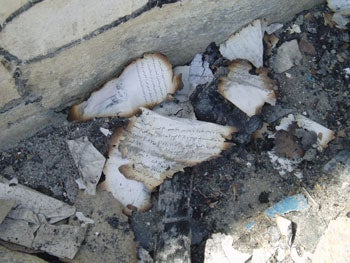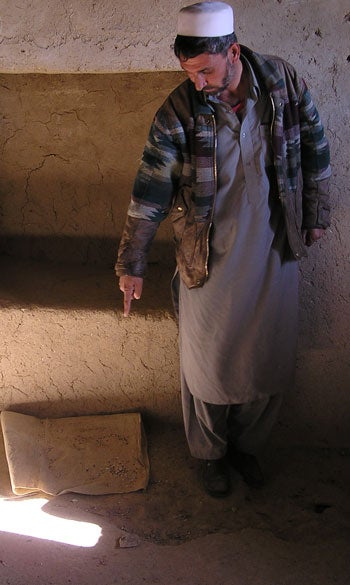|

An abandoned girls’ school in Wardak province, just south of Kabul, vacated in late 2005 because students discovered an explosive device left inside. A threatening “night letter” ordering the school to be closed was left at the local mosque before the attempted attack. © 2005 HRW/Saman Zia-Zarifi.

Charred pages from textbooks burned in a fire set by an opposition group at a school in Lashkar Gah, Helmand. © 2006 Human Rights Watch
|
|

An education official points to the spot where an explosive device was left at the front of the class of a girls’ school in Wardak province in late 2005. The mine was defused but the school building was abandoned. “Of course I’m anxious, for my own daughters—it’s not fear, it’s frustration. How long will this last? What do these people want?” he told Human Rights Watch. © 2005 HRW/Saman Zia-Zarifi.
|
|
Chart of 204 Attacks from January 2005 to June 21, 2006
Click here to download the PDF [16 pages, 97 kb]. Of these attacks, 110 occurred in the first half of 2006. The pattern of these reports indicates a sharp rise in the targeting of Afghanistan’s education process in late 2005 and in 2006. As shown by the graphs in the summary of this report, while southern and southeastern provinces generally experienced more attacks, northern provinces were not exempt. Indeed, attacks were reported in twenty-eight of Afghanistan’s thirty-four provinces. |
Who's Responsible
The Taliban and Other Opposition Groups
The Taliban are believed to be responsible for many (but by no means all) of the attacks on teachers, students and schools documented in Human Rights Watch’s report “Lessons in Terror: Attacks on Education in Afghanistan.” In many cases, self-styled “spokesmen” for the Taliban (chiefly Mohammed Hanif and Qari Yousuf Ahmadi) explicitly claim responsibility for the attacks by contacting the media, although it is impossible to determine to what extent such spokesmen are genuinely representative of the Taliban and have access to information. In other cases, the attacks are associated with “night letters” issued by groups identifying themselves with some variation on the title of “the Taliban” or on stationary bearing the stamp of the Islamic Emirate of Afghanistan, the name of the Taliban government that controlled much of the country between 1996 and 2001.
After the United States ousted the Taliban from power in December 2001, Taliban forces regrouped in their historic powerbase: Afghanistan’s southern provinces, particularly Kandahar, and Pakistani Balochistan and Waziristan. Experts today believe that the Taliban movement combines as many as 40 militant groups, some organized as political factions, others based on Pashtun tribal or regional affiliations. The Taliban seem to be operating under three separate geographical command structures, corresponding to the major political centers of southern and southeastern Afghanistan: Jalalabad, Paktia/Paktika, and Kandahar. Taliban activity in each area (as well as in Balochistan and Waziristan) seems to be coordinated through a series of shuras bringing together some Pashtun tribal militias and representatives of various organized political groups, such as the Taliban, Gulbuddin Hekmatyar’s Hezb-e Islami, and Jalaluddin Haqqani’s group (addressed below). Decisions are made and implemented through consultation between the leaders of the various groups and the local shuras, although it is impossible to establish to what extent a central leadership controls regional action. Smaller groups, such as the Jaish alMuslemin, seem to operate independently of this structure, although they share ideological and political opposition to the current Afghan government and its international supporters.
Gulbuddin Hekmatyar
Another source of attacks on schools is the Hezb-e Islami (“Islamic Party”) of Gulbuddin Hekmatyar, one of Afghanistan’s most notorious and destructive warlords. Hezb-e Islami is essentially a Pashtun force, strongest in southeastern Afghanistan (Nangarhar in particular) and Pashtun areas north of Kabul, such as Kapisa province. Hekmatyar and the Taliban were initially bitter rivals (Hekmatyar was forced into exile after the Taliban conquered Kabul), and as late as November 2002, Hekmatyar publicly denied cooperating with the Taliban. However, on December 25, 2002, Hekmatyar and the Taliban publicly announced that they were coordinating their activity against the Afghan government and its international supporters. Recent press reports indicate that Hekmatyar’s son, Jamaluddin, has represented Hezb-e Islami at meetings with the Taliban.
Jalaluddin Haqqani
Jalaluddin Haqqani is one of the most experienced of the Pashtun mujahideen who fought against Soviet occupation. With a power base in Khost, extending to Paktia and Paktika provinces, Haqqani initially cooperated with Hekmatyar but defected to the Taliban in 1995 and eventually held several high-level posts in the Taliban government. He is now reputed to be the top military commander for the Taliban. Haqqani is alleged to have participated in some of the Taliban’s most brutal campaigns of “ethnic cleansing” around Kabul in the late 1990s. Haqqani is a member of the Zadran tribe and provides a vital link between the Kandahari-based Taliban and the eastern and northern Pashtun groups. Jalaluddin’s son, Sirajuddin, is now believed to exercise considerable day-to-day authority, not just in Afghanistan, but also in neighboring Pakistani Waziristan.
Jaish alMuslemin
Among the various smaller groups carrying out ideologically motivated attacks against teachers and students are the Jaish alMuslemin, a Taliban splinter group based in Kandahar. The Jaish alMuslemin (“Movement of Muslims”) is limited to Kandahar, Zabul, and Uruzgan provinces. The Taliban have in the past denied that they are directly cooperating with Jaish alMuslemin, but local observers in Kandahar often describe the two groups acting in concert in particular attacks. The group’s leader, Sayyid Fazlur Akbar Agha (from Argandab district of Kandahar), was arrested in Pakistan in late 2004. Akbar Agha was one of the Taliban’s original military commanders but apparently formed his own group after disagreements with Taliban head Mullah Omar. It is unclear how active or independent the group is without him.
|
|

|
